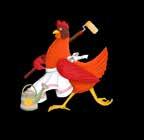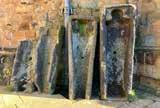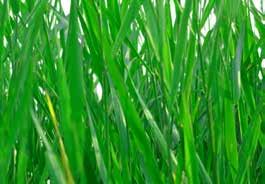
















Who remembers the very first record they bought?
Was it an LP or a single?
Did you have your own record player, or did you have to share the family one?
Why am I asking these questions?
Well…20th April is “Record Store Day”, a day dedicated to independent record shops across the world.
The event began in the US in 2007 with the first official “day” being 19th April 2008. Today thousands of record shops all over the world use “Record Store Day” to celebrate the role they play in bringing music to the masses. Here in the UK at least 260 stores take part every year.
As a child of the 70s, vinyl records were a big part of my life – it helped that one of my aunties actually worked in a record store, meaning I had access to the latest releases at discount prices!
I had a blue “Dansette” record player in my tiny bedroom, and I would spend ages up there listening to my favourite LPs, singing along and trying to dance in the miniscule amount of space ‘twixt bed and wardrobe’.
As time went by the old record player was replaced, first by a “boombox” style radio cassette player (and there hangs another story concerning cassette tapes and pencils…if you know, you know!), and then eventually by a CD player.
But I never forgot the joy of taking a shiny black LP out of the white dust cover. Of reading the song lyrics, revelling in the artwork on the album cover, then carefully replacing the LP in its protective

paper cover and sliding it into the cardboard album. Somehow the tiny cassette and CD packages never had quite the same impact – and the plastic! Wow, all those CD cases that cracked and fell apart – card album covers never did that. We were sustainable in the 70s and 80s – even if we didn’t know it.
So…circling back to the beginning of this article – the first record I bought for myself with my own pocket money was “David Essex”. The second album by him, released in 1974. Even at 11 years old, his blue eyes bedazzled me.
A staggering 50 years have elapsed since that purchase, tastes in music – both mine and in general – have changed, and not always for the better <grin>. But what is remarkable is that vinyl records have survived the onslaught of cassettes, CDs, and digital downloads, and are revered by musical purists as the best way to listen to music.
I’m not sure about that, but vinyl LPs are certainly more of an overall sensory experience than streaming!
And finally – if you want to be a part of Record Store Day, there are three record stores in Sheffield, one in Chesterfield, and one in Nottingham, listed on https://www.recordstoreday.co.uk/ Why not pay one of them a visit and support them?


















Treat yourself to a luxury break at the 4* Gold Award winning Little Red Hen House. An elegant and cosy holiday home just a 7 minute drive from award-winning and dog-friendly Warkworth beach.


✽ 2 spacious en-suite bedrooms
✽ A fully enclosed garden
✽ 2 small to medium dogs welcome (3 upon request)
✽ Fully equipped kitchen, including an American style fridge freezer


✽ Perfect for exploring the stunning Northumbrian Heritage Coastline
✽ Close to a range of dog friendly pubs, cafes and restaurants in stunning Warkworth
✽ We have fast fibre Wi-Fi and smart TV’s
Search ‘The Little Red Hen House’ at:

www.coquetcottages.co.uk









Ground Floor, Multi-Story Car Park, New Beetwell Street, Chesterfield, S40 1QR
Boot Scooter



Manual Wheelchair

If you require a Manual Wheelchair or a Boot Scooter to hire to take away or stay at home we can help you
Wheelchair and Electric Scooter hire
Servicing Battery & Charger Testing

Breakdown and repair services
Safety checks
Driving Tests
TRACKS AND TRAILS TASTER DAYS - Further dates coming soon!
Opening Hours: Monday to Friday: 10.00am – 4.30pm Saturday: 10.30am – 3.00pm
Chicken Donburi Yakitori
Method:
1. Put the chicken in a ceramic bowl and sprinkle over the soy sauce. Toss well to coat.
2. Cook the rice according to the pack instructions, then drain well and keep warm.
3. At the same time, spray a non-stick wok or large frying pan with low-calorie cooking spray and put it over a high heat. Add the chicken strips and stir-fry for 2-3 minutes, or until browned.

I love Japanese food, so When I saw this recipe I thought, we have to include it. Quick and easy to make. Filling and full of flavour. This recipe ticks all the boxes.
4. Add the vegetables and stir-fry for 4-5 minutes.
5. Pour in the teriyaki sauce and stock and stir-fry for 4-5 minutes, or until piping hot and bubbling.
6. Divide the rice and chicken mixture between 4 bowls, and sprinkle over the shredded seaweed, if using, to serve.
For more information visit
www.slimmingworld.co.uk

Ingredients:
• 3 large skinless and boneless chicken breasts, cut into strips

• 4 tbsp dark soy sauce
• 250g dried long-grain white rice
• Low-calorie cooking spray
• 2 carrots, cut into matchsticks
• 1 red pepper, deseeded and cut into thin strips
• 100g mangetout
• 150g shiitake mushrooms, stalks removed, very thinly sliced
• 3 level tbsp teriyaki sauce
• 100ml hot chicken stock
• 1 dried seaweed sheet (nori), shredded (optional)
Serves: 4 Ready in: 25 minutes
Syns per serving: 1




Customers Own Car Park or RING FOR FREE HOME SELECTION SEVICE
Supply & Install of all Domestic & Contract Carpets
Supply & Install of all Domestic & Contract Vinyls
Supply & Install of RealWood & Laminate Floorings
Supply & Install of Karndean Floorings
Supply & Install of Sisal & Natural Floorings
Supply & Install Coretec and Quick-Step Flooring





Between 55 BC - 450 AD Romans ruled Britain and its people, we were considered to be part of the Roman Empire. Romans were Christians and during that time they converted most of the population to their religion. When their empire began to crumble, they abandoned Britain and Anglo-Saxon tribes seized the opportunity to invade.
Anglo Saxons were pagans, worshipping many different gods believing their gods looked after different parts of their lives like family, plentiful harvests, the weather, even success in battle.
Around 150 years later, Pope Gregory the Great of Rome, sent his Christian Monks over to Britain to spread the word of Christianity. The monks settled, setting up monasteries and forming local Christian communities.
When the King of Mercia was converted to Christianity in 656, he allowed nine minster churches to be established, Bakewell was one of them. There are no definite records, but it is believed there may have been a church built, on

the site where Bakewell All Saint’s church now stands, as early as the 680s.
From 789 onwards Viking and Danish raiders ransacked the monasteries and minster churches in Britain. Also known as North men or Norsemen, Danes were considered to be heathens. Vikings and Danes all came from pagan regions who believed in gods such as Thor the god of thunder and, most powerful of all the gods, Odin, also known as Woden, god of warfare, wisdom, justice, death and poetry. Slowly, as time passed, the population adopted Christian values blending them with their own beliefs.
It is almost certain that a building would have existed on the present site of Bakewell Church by 800, but in 949 a new church was erected replacing the earlier one. When the Domesday book was published in 1086 the only churches in Derbyshire to have two priests were Repton and Bakewell.
Bakewell church was rebuilt in Norman style in 1110, probably by William Peverel. Around 1250 - 1300, the building was enlarged and extended. In the 1400s battlements were added and by the 1800s the Vernon Chapel was completed, and the church looked much as it does today. By 1825 both the tower and spire were in danger of collapse. The spire was pulled down at this time, (coinciding with a visit to the area by Turner, who sketched it) and the tower was demolished in 1830. Both tower and spire were rebuilt during renovations between 18411852.
Today when you visit All Saints Parish Church a plan, located on the back (west) wall of the church,
shows how the church building has developed over the centuries. Inside the church is beautiful. There are stained glass windows, intricate carvings, monuments, mosaic floors, tombs and much more to see in this lovely church.
Outside are the remains of two stone crosses, a huge collection of early medieval stones carvings, early medieval stone coffins, fabulous gargoyles and many interesting gravestones. A trip to Bakewell wouldn’t be complete without a stroll up the hill to visit the church.
And coincidentally, our fantastic Bakewell Old House Museum is just a step beyond the church. Hidden away in Cunningham Place the museum is still one of Bakewell’s best kept secrets. It’s well worth a visit - plus you will be blessed by a grand view of Bakewell as you wander back down into town.


We will be open and happy to welcome you from 25th March 2024. And don’t forget our popular group tours of the town, tours of the museum and ghost tours are all available as are museum tours for schools. Please see the website for opening hours and prices. Alternatively contact the museum to book or for details of tours.




























Forlornly wandering around Paris after her husband as he pursues his interest in puppet theatres, Marianne is struck by the unfairness of his accusation that she can be a bloody difficult person to like.
She reckons she has done her best. She married said husband - her best childhood friend Hugo - and has tried to give them a good life. Then it strikes her that “her best” has left her like a sick grey parrot in a cage, in the wrong place at the wrong time and with the wrong people.
Absolutely and Forever by Rose Tremain is the story of a naïve and innocent girl who as a teenager falls headlong in love with a perfect human being – not the man who ends up as her husband needless to sayand spends most of her life lost to an imagined perfect life with the perfect man.
She’s very much the product of her middle class suburban 1960s-70s upbringing, although the swinging sophistication and early feminism of the period seems to be in a different world. At one point she sees herself turning into her mother. The descriptions of her parents’ world are really entertaining in a wince kind of way.
Marianne is infuriatingly uncertain of herself, but also someone you want to hug even while she’s driving you mad. It’s a story of a young love which can only go wrong in the real world but it’s also funny and astute and subtle and pokes gentle fun at the times it is set in. The writing fizzes along and it’s an interesting take on how we get trapped in our lives by the things around us, and by our own perceptions. A perfect little gem.

Maintenance free Timber Alter native Windows & Doors from Evolution. With all the beauty of traditional timber, our wood effect windows and doors have to be seen to be believed.


Maintenance free Timber Alternative Sash Windows from the Bygone Collection. The most energy efficient, authentic, timber alternative sash window on the market. Exceptional build quality, with an unprecedented 12 year guarantee.







iconic steel replica, heritage, Art-Deco or industrial-styled glazing solutions. Aluco delivers expertly crafted, cleverly designed, and above all, authentic


Stained glass conservation refers to the protection and conservation of glass for future generations. It involves any and all actions devoted to the prevention, mitigation or reversal of the processes of deterioration that affect such glassworks and subsequently inhibit individuals’ ability to access and appreciate them, as part of the world’s collective cultural heritage.
The fabric of the glass itself, the paint or stain used to decorate it, and even the metal framework and/or the stone used to hold the design together are all at risk of deterioration, and will likely require conservation work to ensure their long-term survival. Stained glass is subject to damage caused by a number of factors including exposure to pollution, weathering etc. as well as the innate fragility of glass and any potential chemical instability of the materials involved (Brown et al. 2002, xi; Rauch 2004). Other aspects include extreme weather, improper handling or indeed deliberate damage.(Vogel et al. 2007).
The vast majority of stained glass was originally created to function as part of the building envelope, enabling local communities to understand stories associated with religion or other commemorative matters. As a result, most historic glazing that has been left in situ is subjected to a constant onslaught of harmful conditions including (but not limited to): UV light from sunlight, extreme weather conditions, indoor and outdoor manmade pollution, and biological damage caused by pests such as pigeons, bats, and various microorganisms (Rauch 2004, 3).
Historic glass can deteriorate through other issues such as chemical stability resistance to natural deterioration, impurities, and variations in glass composition can cause further destructive processes to enact. Over time, pitting of the glass can worsen until the glass becomes almost opaque.
Other defects can start to occur: the breakdown of the paints, enamels or stains used to create the effects. In some case structural deformation and deterioration can happen where the stone, metal strips become bowed to the extent glass is no longer held in place and weather can accelerate the demise

Restoration can take a number of forms: Simple cleaning is effective but care of the surfaces must be considered. Carefully applied deionized water is one option, taking care not to remove any loose paint. Even this process should be consulted with the relevant authorities and conservation bodies to ensure damage isn’t done.
Repairs are meant to last but with the glazing best practice should be sought. In the context of stained glass, repairs can involve treatment of the glass itself, treatment of missing areas, or structural consolidation of the panel or surrounding architectural stonework.
Missing areas or broken areas can be filled or replaced but should be done so with caution.
Protective glazing – almost a sandwich of glazing that allows good air flow but has to be professionally created so not to act as a measure that works against the conservation of the glass itself.
Final word: if in any doubt seek professional advice from your local authority conservation officer, church authority or an architect.



Please get in touch if you have any community history projects in your area, we might be able to help! Contact Richard Godley on


Residential
Working on installation, maintainence, upgrading and rennovation electrics in residential properties.
Commercial
With several years experience in commercial electrics, I am confident and experienced in all ranges of tasks and projects.
Testing
Whether it may be a job involving lighting, home electronics, security systems, outdoor buildings & more, I am ready for the job.
dma.electricalservices@outlook.com
www.dmaelectrics.co.uk







Get in touch for your free, no obligation quote:
T: 07811 646690
E: d.butterworthplumbingandheating@gmail.com
www.dbutterworthplumbingandheating.co.uk
(based in Monyash, near Bakewell)




Both my mum and my granny had big tins which contained a wide variety of “bits and bobs” and sewing accoutrements: treasure trove to a small girl. In my mum’s case it was a large old Quality Street tin with a tight-fitting lid which was kept in the “glory hole” or under-stairs cupboard – a semi-lit cave filled with fragrances of shoe polish and dust. When she needed something from it, she would call out, “Janny, fetch “The Tin” for me” and I would gladly collect it from its designated place in the glory hole.
As well as her sewing and button collection, it held a single sock with a hole in the toe. We never had a proper darning mushroom; mum used an orange instead. But she did have several cardboard rectangles with different colours of wool wound round for mending woollen clothes.
Some of the more unusual objects which found themselves consigned to “The Tin” were a metal whistle, a single fuse, odd keys, an Edwardian button hook, lengths of string, a kilt pin, hair grips, a plastic fork for eating dates at Christmas and fairy light bulbs. There were also many unidentifiable objects or parts of things which went to live in the tin until they were reunited with the missing bit.

Some of these had been in “The Tin” for so long that their original use had been long forgotten but their place was assured for all time because they “might come in handy one day”.

The sewing items were most often used and were stored in a separate box within “The Tin” except for the pin cushion which remained the vibrant and prickly star of “The Tin”. The first thing that greeted you as the lid was eased off like a bejewelled hedgehog.


I have gathered together a bits and bobs basket for our reminiscence sessions containing many of the remembered items from my childhood. People love to rifle through it and rediscover long lost memories. Did you have a bits and bobs tin, box, drawer or basket?
Janet and Paul Barrass are All Around the Shire.









(no – not that kind of double D!) “Daisy, Daisy, give me your answer do.”
No, I’m not going mad (that happened ages ago), daisy is actually the flower of the month of April!
Daisies are common and inexpensive (sometimes unwanted) flowers.

There’s something quite fresh and almost naïve about a daisy, at least the type of daisy that immediately springs to mind…it doesn’t pretend to be anything glamorous, you can’t pick a bunch and stick them in a vase – well you could, but it would have to be a very small one. They are simple; white petals, yellow centre, and they love to peek out of our lawns – a very welcome sign that spring has sprung…although many a lawn purists may disagree.
Of course, there are other varieties of daisy other than the humble lawn one (Bellis Perennis) – in fact there are apparently over 20,000 different kinds, spread across the globe. These include artichokes, calendula (pot marigold), chamomile, echinacea, oxeye daisy, Michaelmas daisy and sunflower. So, not as simple a flower as one may at first think.
I came across this snippet of a poem which, for me, neatly encapsulates how I feel about daisies: ‘The daisy is a happy flower, And comes at early spring, And brings with it the sunny hour, When bees are on the wing.’ – John Clare, “The Daisy”. If every month of the year has a flower associated with it, it stands to reason that other “stuff” is also linked to months…things like gemstones, for example.
April sticks with the initial “D” for its associated stone…diamond.
Daisies and diamonds – polar opposites, really.

Diamonds, on the other hand, are relatively rare, and ridiculously expensive bits of pressure cooked carbon!
They (diamonds, that is) were formed long before dinosaurs roamed the Earth; the “youngest” diamond is nearly a billion years old, and they are the hardest natural substance known to man. The hardness of the stone makes it really difficult to cut and polish, and yet, if you have ever seen a “raw, uncut” diamond, you will see why, for thousands of years, jewellers have attempted to do so. For a raw diamond, whilst still pretty, is not particularly sparkly – to me, they look more like chunks of ice.
It’s the facets and angles of a cut and polished diamond that cause it to reflect and refract light, and therefore appear to glitter, making them a sought after stone for those who enjoy a bit of bling. And of course, they are often the stone of choice for engagement rings…

Which brings us neatly back to my opening line – there is always a method in my madness, you know! As the verse goes on to say, “it won’t be a stylish marriage, I can’t afford a carriage”, I think it’s safe to say that poor old Daisy didn’t receive a diamond ring as part of her proposal.
Oh well – diamonds may last forever, but lawn daisies are perennial…same kind of idea, isn’t it?!







These puzzles are devised by the brilliant Professor Rebus. For more of his puzzles visit www.pitcherwits.co.uk

Pitcherwits® are crossword puzzles where some of the clues are in pictures.
Sound easy? It’s not called “Pit-your-wits” for nothing!
The mixture of cryptic and picture clues, combined with Professor Rebus’ unique sense of humour, will keep you entertained for hours.

1 Ill-fated plan to go to war in a states copcar (6,5)
5 Siân, having an ego that could cause such pains! (7)
14 See arms as about to embrace an old Egyptian (7)
16 Vat, with ‘ant’ label, cracked in sea struggle (5,6)




Across
9 Leave out no mitigating circumstances, however small (4)
10 Grid, about to encircle (4)
11 Back to lady’s alternative (5)
12 An ocular sort of flower for Murdoch? (4)
13 Approached with inner pain (4)
2 Tell you later which tab to use (1,1,1)
3 Andre Agassi to have his own cooker (3)
7 Absent on three separate occasions (3,4)
14 Vicar, mentioned briefly in the Book of Revelations (3)
15 ‘Tis complicated, so park yourself (3)
1 Pops in to Rio to make a suggestion (11)
4 He’d a venison sandwich that just isn’t sticky! (3-8)
6 A stooge who intended to join the Navy (2,2,3)
8 Avenger’s plan to carve in script (7)




Down: 1 Beachcomb, 2 Elegies, 3 Ash, 4 Ski, 6 Pay rise, 7 Tea, 8 Capturing, 10 Whippet, 13 Mac, 16 Use, 17 Lah.
Across: 1 Blue whales, 5 Emphatic, 9 Crag, 10 Wasp, 11 Earth, 12 Ohms, 14 Pier, 15 Buckle up, 18 Enchanting.
ANSWERS FOR LAST MONTHS PITHERWITS
These puzzles are devised by the brilliant Professor Rebus. For more of his puzzles visit www.pitcherwits.co.uk

























Whilst there are clearly still problems for birds of prey in and around the Peak District and North Derbyshire, recent decades have witnessed some spectacular recoveries such as by common buzzard especially, and but more localised, red kite too. Peregrines are doing well in urban areas where they nest on tall buildings and consume feral pigeons, but they still suffer persecution and disturbance in the Peak itself. There are other similar stories but that is maybe for another occasion. However, two of our more familiar birds of prey are a falcon, the kestrel, and a hawk, the sparrowhawk, and their recent histories are a little different. The kestrel was almost the only bird of prey that was still fairly abundant in the 1970s, whereas I now recall my first local sparrowhawk viewing as a ‘redletter day’! The bird, a female, was high over the Rivelin Valley on the eastern edge of the Peak District moors. The characteristic rounded wings, long tail, and the ‘flapflap-glide’ flight were very obvious. Kestrel on the other hand was a fairly common sighting that we expected on any outing to suitable habitat, and of course which thrived along the grassy verges of motorways and dual carriageways where they fed on abundant voles and mice. Unlike other birds of prey, kestrels escaped the worst of pesticides and also of persecution.
However, whilst kestrels thrived along their newly-created motorway habitats, the sparrowhawks were pretty much under the cosh and numbers plummeted, until perhaps the early 1980s. Regulation of both pesticides and (by now illegal) persecution meant sparrowhawk numbers started to increase. Other birds of prey, especially common buzzard also began a dramatic increase in both

MALE SPARROWHAWKS
BY IAN ROTHERHAMnumbers and geographic spread, the latter connected to a decrease in gamekeeping across lowland England. It seems that an unexpected consequence of the rise of the buzzards has been their emergence as direct competitors for feeding habitats (such as the roadside verges) with their smaller cousins, the kestrels. Moreover, buzzards are quite territorial and can be aggressive on breeding sites and in feeding areas. The overall result does seem to be a decrease in kestrels and the rise of buzzards and kites along roadside grasslands.
Nowadays, the sparrowhawks have really come good and in many areas are quite abundant. In gardens both in the countryside and around the urban fringe they are doing well and are apt to take up residence close to bird-feeders. Whilst the loss of your garden blue tits, great tits, siskins, and the like can be distressing to witness, it is part of nature’s great cycle of life and death. The idea of rewilding nature and the countryside hinges greatly on the re-establishment of what we call ‘trophic levels’, i.e., the feeding levels of one-time regionally extinct predator and prey interactions in the food-chains. This drama of rewilding is acted out in and around our gardens every day, and predators like the sparrowhawks are stunning birds, but they do have to eat! Furthermore, the predators take out numbers of young birds that would otherwise starve during the winter months, and balance is maintained.










Lawns appreciate a bit of love after the ravages of a wet winter. April is the best time to re-seed baldy bits if there’s a bit of warmth. Dig the patch over and add a bit of fresh soil if it’s looking tired.
Rake over and make sure the seed has proper contact with the soil, plant about an inch deep if you can and tread in. Even if you’re just seeding over existing lawn make sure the seed is well trodden in. Water. If you’ve got uneven hollows or ridges just carefully peel back the top layer of turf and either remove or add soil and replace the turf, treading it down firmly. If you don’t like moss in your lawn or your grass is looking a bit ragged use a wire rake to pull out the debris – it will look a bit messy for a while but will repay the effort.
When using your glorious home-made compost to reinforce border soil be careful how you lift it from the compost heap or bin. Most hibernating creatures such as hedgehogs should be gone by now but it’s best to avoid attacking the compost pile with long tined forks or sharp spades, just in case.
Deadhead your daffs but leave the foliage to die down neatly and don’t tie. That way the energy will go back into the bulb and give you a good show net spring.
For a cottage garden look scatter the kind of seeds which used to grow in cornfields before intensive farming got to them. The likes of cornflower and poppies will give you a quick blast of colour and are great tor encouraging early pollinating insects.

The chlorine in the tap water most of us use for watering houseplants can actually harm growth. But if you leave it standing in an open jug for 24 hours a lot of the chlorine will





BASED IN WIRKSWORTH, GOODWINS ARE A TEAM OF KITCHEN, BEDROOM AND BATHROOM CONTRACTORS THAT MANAGE YOUR PROJECT FROM START TO FINISH. GET IN TOUCH TODAY.
OUR VALUES
• WE TAKE GREAT PRIDE IN WHAT WE OFFER AT GOODWINS, AS WE’RE ABLE TO HELP YOU CUSTOMISE YOUR HOME EXACTLY HOW YOU WANT IT.
• WE’LL ALWAYS TAKE THE NECESSARY TIME TO TRULY UNDERSTAND YOUR VISION TO ENSURE THAT WE’RE OFFERING YOU EXCEPTIONAL SERVICE AT ALL TIMES.
• USING THE LATEST 3D DESIGN SOFTWARE, WE’RE ABLE TO PROVIDE YOU WITH BESPOKE PLANS THAT GIVE AN ACCURATE IMPRESSION OF HOW YOUR ROOM WILL LOOK.
• MOST IMPORTANTLY, WE’LL ALSO PUT FORWARD MULTIPLE OPTIONS AND IDEAS TO HELP YOU DECIDE ON A FINAL LOOK.


-FRIDAY : 09:00 - 17:00
: 09:00 - 16:00





